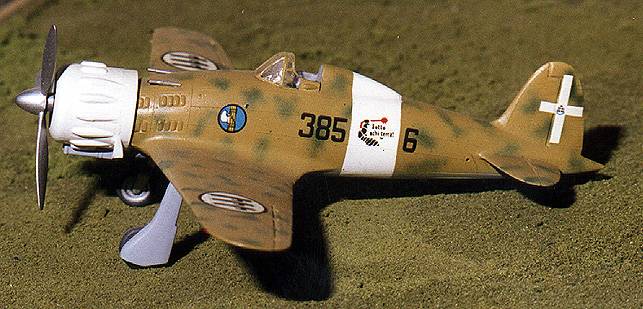
Revell 1/72 Macchi MC.200
Kit Number: 4160
Price: $3.00
Decals: one version
Reviewer: Scott Van Aken
Date of Review: 20 August 1997

Macchi's MC.200 was their first attempt at a monoplane fighter with retracting landing gear. Initially flown with a full canopy, the Italian pilots, who were used to open cockpits, felt claustrophobic and had it modified to a more open variety. Typically underpowered and underarmed, the MC.200 saw service on all fronts during the early years of Italy's involvement in WWII. Once its limitations were discovered, it was removed from front line duty. Never built in as large a number as the aircraft of other powers, the MC 200 led the way to the much more capable MC.202 and MC 205, which were basically the same airframe powered by Daimler-Benz inline engines.
The Revell kit of the MC.200 was for years a highly sought collector's item, being the only injected kit available of this important aircraft. It is still the only injected kit in 1/72. Unfortunately, it is of such an age that there are no aftermarket bits available that I am aware of, and only one decal sheet, produced by ESCI. Additional info would be helpful.
It is a kit typical of the 60s with raised panel lines, slightly heavy-handed detail, no real cockpit other than a seat and a pilot, open wheel wells and simple construction. You can see from the interior to the ground through the wheel wells. My kit suffered from sink marks on the ailerons, which I was too lazy to fill. The most tedious part of the kit was the engine cowling with all its lumps and bumps. This part took a great deal of time to clean up. I guess there is no easy way to make this type of cowling as every kit I have built with this feature has been a lot of work.
Anyway, construction will pose no problem at all for builders with a few kits under their belt. Other than the cowling, some filler will be needed for the wing/fuselage join. The canopy fits very well and was easy to mask prior to painting. The engine is rather nice and some dry brushing will bring out the highlights. The main landing gear is a bit complicated and needs careful assembly, mostly because the wheel forks are separate to allow the wheels to roll. Mine had so much slop in them, that I super-glued them.
On to painting. First off, the interior was painted a light grey and all undercarriage pieces were done in aluminum. This kit was painted in the Mediterranean scheme of sand with green splotches over medium grey. All the colors were mixed as no specific WWII Italian colors existed. I took the scheme from a Squadron-signal book on the Italian AF from 1935-1943. The area for the white fuselage band was pre-painted white and then masked. The cowling was painted white and then added when the other colors had been done. This kit supplies a sand filter to be added later. The book showed this to be underfuselge and not cowling color. The Revell decals were pretty yellowed and useless by the time I got to building the kit, so I used an almost as yellowed ESCI sheet. Surprisingly, the ESCI decals actually fit rather well. They are quite flat and respond well to setting solutions.
The end result is a nice little kit. If you have a penchant for these types of easy-to-build kit, Revell produced a number of them including a P-40, Spitfire, Tempest, PZL11c, P-26 and a few others. They are now no longer so highly sought and can be purchased for a very little cash outlay. I must warn you that some were real dogs, such as the P-51, P-47 and Bf-109E, so stay away from them.
Copyright ModelingMadness.com. All rights reserved. No
reproduction without express permission from the editor.
Back to Reviews Page 2016